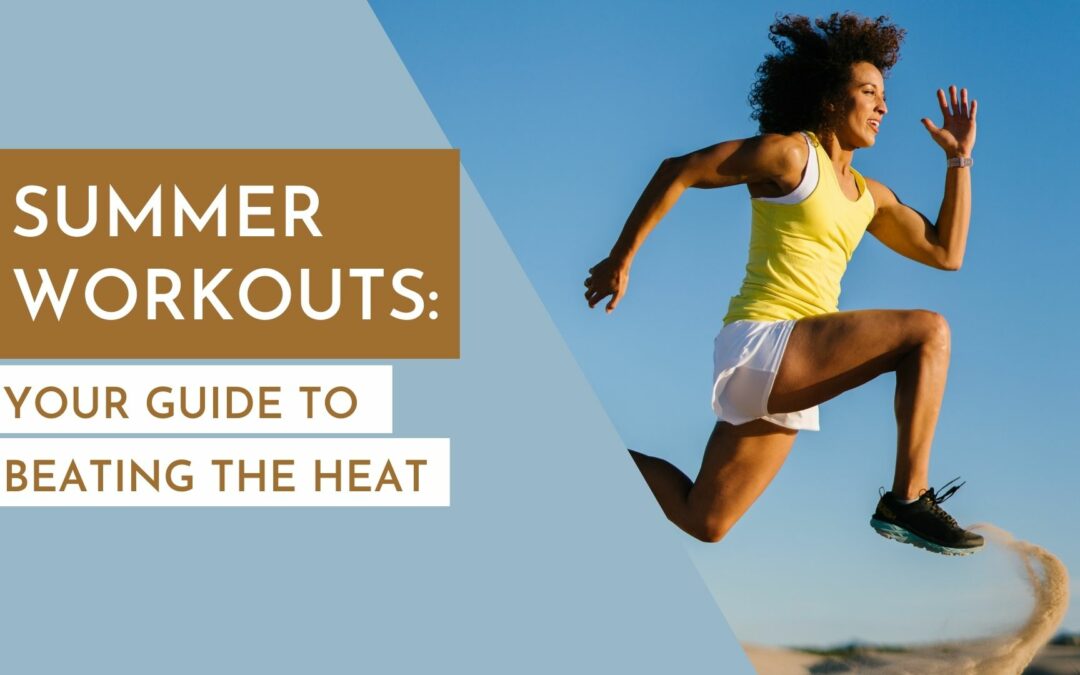With summer on the way, most of us have begun transitioning some of our active time to the great outdoors. Then all too soon, these lovely early summer days can turn hot and zap our motivation. But hot weather workouts are all about being strategic. With some planning and adaptation, you can hit your goals while staying safe and having fun.
Seven Tips to Adapt Your Workout Routine for Hot Weather
Dress for heat & safety
Dressing in layers allows you to adapt to changes in temperature throughout the day. Choose lightweight pieces that wick away sweat to keep you dry and comfortable. Lighter-colored clothing may help keep you cool by reflecting more light (which becomes heat) away from your body. When walking or running near traffic areas, wear bright colors and choose clothing with reflective surfaces to increase your visibility to nearby motorists.
1. Hydrate appropriately
Staying hydrated in the heat takes more fluids than you think, so planning ahead is essential. Start drinking earlier in the day, about two to three hours before you plan to exercise. Try to drink some fluid every 10-20 minutes when working out in the heat. Then drink a full glass of fluids within 30 minutes of completing your workout.
- Sports drinks and water enhancers can help you replace electrolytes like sodium, calcium, and potassium that you may lose during your workout.
- Staying fully hydrated can reduce your chances of getting muscle cramps, dizziness, or headaches.
- Avoid drinking beverages like coffee, tea, and lemonade before and during exercising because they can act as a diuretic.
2. Work out earlier or later at dusk and dawn.
Many people think the hottest part of the day is noon because the sun is directly overhead, but the hottest temperatures of the day usually occur between 3:00 and 4:30 in the afternoon. If you’re used to catching a workout on your lunch hour, summer is a perfect excuse to shake up your routine. Try working out early in the morning or later in the evening to avoid the extra heat and UV rays. Make sure to wear bright, reflective clothing when exercising at dawn or dusk to stay visible. If you’re going to hit the road for a pre-dawn or night run, consider a headlamp or blinking beacon.
3. Love it indoors
If the heat is just too much, mix up your routine by moving part of it indoors on the hottest days. Besides gyms, there are many opportunities to move your body in the blissful comfort of AC.
- Group fitness classes at community centers
- Spinning and HIIT clubs (OrangeTheory, SoulCycle, etc.)
- Streaming classes at home
- Yoga studios
- Mall walking clubs
4. Adapt to the season
Take advantage of warm weather activities by enjoying what the season offers. Go swimming, mountain biking, or hiking. Many parks have paved areas for rollerblading or skateboarding. If you’re lucky enough to live near any body of water, try paddleboarding for an excellent balance and upper body workout. Or do a little of everything during a weekend camping trip.
5. Train for the heat
Exercising in the heat can help improve your performance by increasing your overall oxygen intake and increasing your body’s ability to cool itself. Still, this kind of adaptation takes time and requires a careful approach.
To train for heat, start your workouts earlier when the heat isn’t as intense and gradually work towards the hotter parts of the day. Start light and increase the intensity and duration of your workouts over time. This may mean that you have to go lighter and slower than your spring pace at first. It can take up to five weeks to acclimate your body to the heat. Listen to your body and stop when you need to. If needed, break your exercise into smaller chunks so you can rest in between sets. Pushing through with intense exercise in the heat elevates your risk of heat exhaustion and heat stroke, which can be serious, so stay hydrated and aware of your body’s response to the heat.
Signs of Danger:
- Lack of sweating
- Headache
- Nausea
- Vomiting
- Seizure
- Unconsciousness
6. Sun protection
Exercising outdoors means increased sun exposure, and all sun exposure is cumulative. Many of us are guilty of only applying sunblock when we know we’ll be out for an hour or more, but those little exposures add up! Take precautions against sun damage by applying a waterproof sunblock before exercising. Stop at least every 80 minutes to reapply the lotion if you’re sweating or swimming. Clothing such as lightweight, long-sleeved shirts, brimmed hats, and sunglasses can also help protect against sun damage.
7. Prepare for the weather
Summer weather is the least predictable in many areas, so pay attention to local weather alerts for things like high UV exposure and poor air quality. When it’s humid, the body also has a harder time cooling itself down because sweat doesn’t evaporate as quickly or as easily. Then, of course, there are all those summer hazards like lightning storms, monsoon rains, wildfires, and the poor air quality that comes with it. If you’re heading out to enjoy a long summer hike, go prepared for extreme heat and an icy downpour.
Summer is one of the best seasons for being active because there are so many attractive options. But summer is also called “The 100 Deadliest Days” for a good reason. With a little planning, you can stay safe, meet your goals, and collect a season’s worth of new memories.

